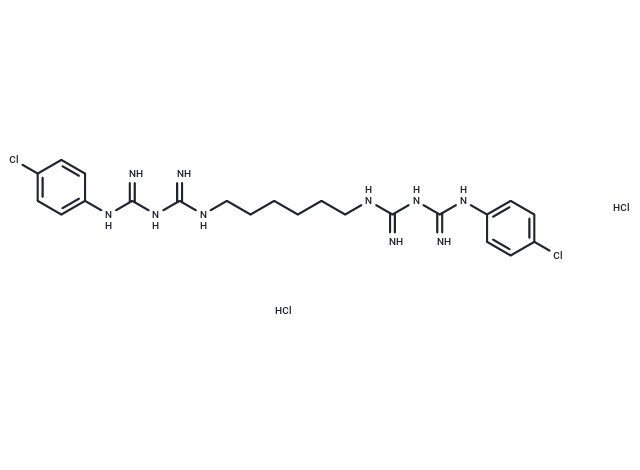Shopping Cart
- Remove All
 Your shopping cart is currently empty
Your shopping cart is currently empty

Chlorhexidine dihydrochloride (NSC-185) is a disinfectant and topical anti-infective agent used also as mouthwash to prevent oral plaque.

| Pack Size | Price | Availability | Quantity |
|---|---|---|---|
| 10 g | $35 | In Stock | |
| 1 mL x 10 mM (in DMSO) | $29 | In Stock |
| Description | Chlorhexidine dihydrochloride (NSC-185) is a disinfectant and topical anti-infective agent used also as mouthwash to prevent oral plaque. |
| In vitro | Chlorhexidine is a chemical antiseptic.It is effective on both Gram-positive and Gram-negative bacteria, although it is less effective with some Gram-negative bacteria.It has both bactericidal and bacteriostatic mechanisms of action, the mechanism of action being membrane disruption, not ATPase inactivation as previously thought.It is also useful against fungi and enveloped viruses, though this has not been extensively investigated. Chlorhexidine is harmful in high concentrations, but is used safely in low concentrations in many products, such as mouthwash and contact lens solutions. |
| Alias | NSC-185, Chlorhexidine hydrochloride, Chlorhexidine 2HCl |
| Molecular Weight | 578.38 |
| Formula | C22H32Cl4N10 |
| Cas No. | 3697-42-5 |
| Smiles | c1(NC(=N)NC(=N)NCCCCCCNC(=N)NC(=N)Nc2ccc(cc2)Cl)ccc(cc1)Cl.Cl.Cl |
| Relative Density. | 1.284 g/cm3 at 20℃ |
| Storage | Powder: -20°C for 3 years | In solvent: -80°C for 1 year | Shipping with blue ice. | |||||||||||||||||||||||||||||||||||
| Solubility Information | Ethanol: < 1 mg/mL (insoluble or slightly soluble) DMSO: 93 mg/mL (160.79 mM), Sonication is recommended. | |||||||||||||||||||||||||||||||||||
Solution Preparation Table | ||||||||||||||||||||||||||||||||||||
DMSO
| ||||||||||||||||||||||||||||||||||||

Copyright © 2015-2025 TargetMol Chemicals Inc. All Rights Reserved.